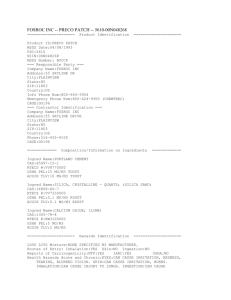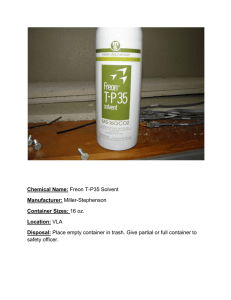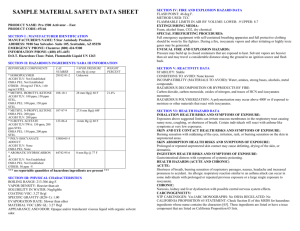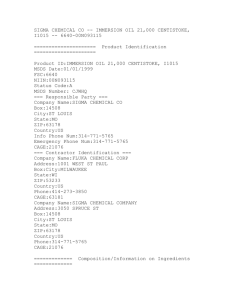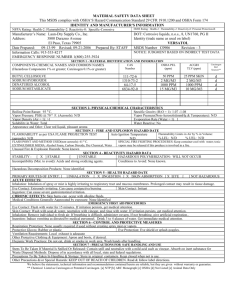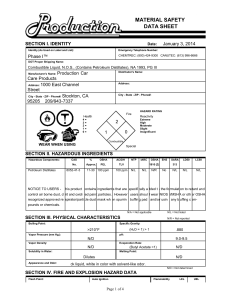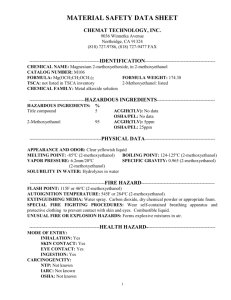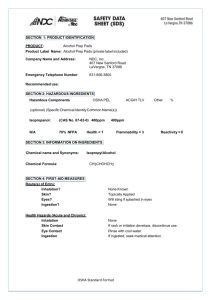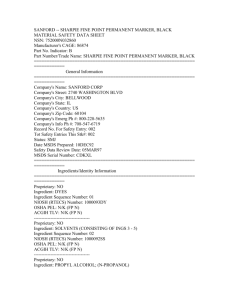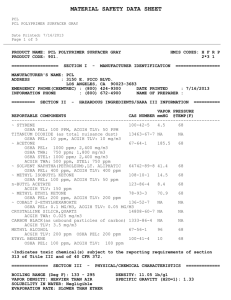www
advertisement
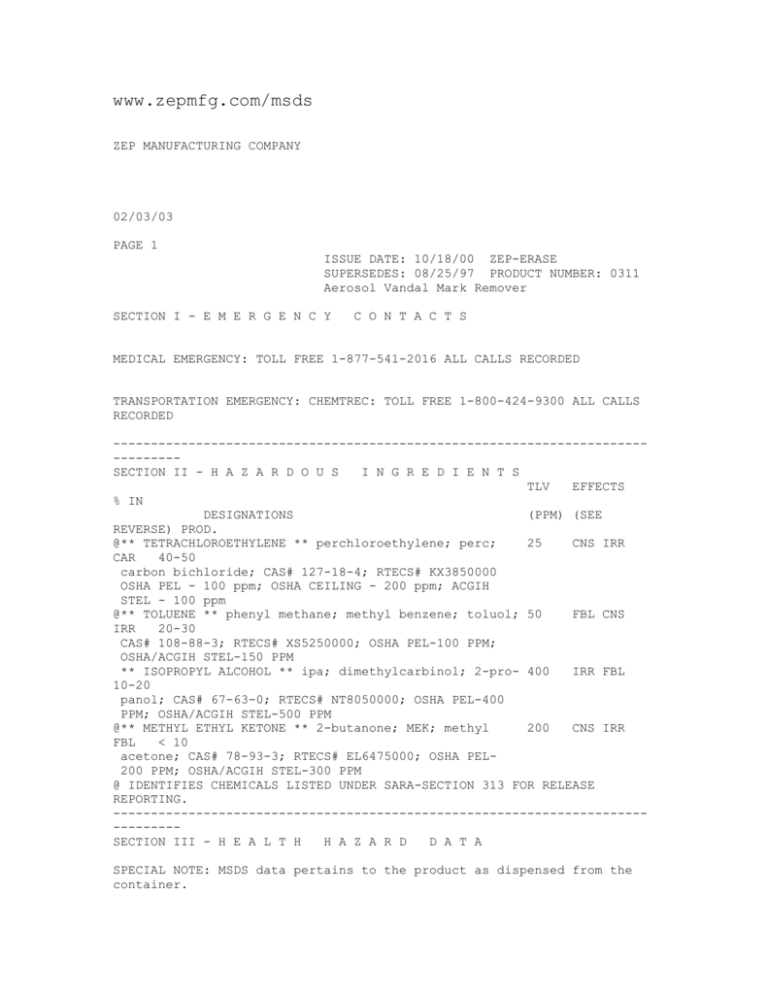
www.zepmfg.com/msds ZEP MANUFACTURING COMPANY 02/03/03 PAGE 1 ISSUE DATE: 10/18/00 ZEP-ERASE SUPERSEDES: 08/25/97 PRODUCT NUMBER: 0311 Aerosol Vandal Mark Remover SECTION I - E M E R G E N C Y C O N T A C T S MEDICAL EMERGENCY: TOLL FREE 1-877-541-2016 ALL CALLS RECORDED TRANSPORTATION EMERGENCY: CHEMTREC: TOLL FREE 1-800-424-9300 ALL CALLS RECORDED ------------------------------------------------------------------------------SECTION II - H A Z A R D O U S I N G R E D I E N T S TLV EFFECTS % IN DESIGNATIONS (PPM) (SEE REVERSE) PROD. @** TETRACHLOROETHYLENE ** perchloroethylene; perc; 25 CNS IRR CAR 40-50 carbon bichloride; CAS# 127-18-4; RTECS# KX3850000 OSHA PEL - 100 ppm; OSHA CEILING - 200 ppm; ACGIH STEL - 100 ppm @** TOLUENE ** phenyl methane; methyl benzene; toluol; 50 FBL CNS IRR 20-30 CAS# 108-88-3; RTECS# XS5250000; OSHA PEL-100 PPM; OSHA/ACGIH STEL-150 PPM ** ISOPROPYL ALCOHOL ** ipa; dimethylcarbinol; 2-pro- 400 IRR FBL 10-20 panol; CAS# 67-63-0; RTECS# NT8050000; OSHA PEL-400 PPM; OSHA/ACGIH STEL-500 PPM @** METHYL ETHYL KETONE ** 2-butanone; MEK; methyl 200 CNS IRR FBL < 10 acetone; CAS# 78-93-3; RTECS# EL6475000; OSHA PEL200 PPM; OSHA/ACGIH STEL-300 PPM @ IDENTIFIES CHEMICALS LISTED UNDER SARA-SECTION 313 FOR RELEASE REPORTING. ------------------------------------------------------------------------------SECTION III - H E A L T H H A Z A R D D A T A SPECIAL NOTE: MSDS data pertains to the product as dispensed from the container. Adverse health effects would not be expected under recommended conditions of use (diluted) so long as prescribed safety precautions are practiced. ACUTE EFFECTS OF OVEREXPOSURE: Inhalation of vapor can produce central nervous system depression, characterized by dizziness, headache, nausea, cardiac and/or respiratory depression, and stupor. In extreme cases unconsciousness or death could result in poorly ventilated or confined spaces. Exposure to high concentrations of vapor can be irritating to mucous membranes, such as eyes and upper respiratory tract. Severe eye exposure to liquid can cause reversible eye damage. Skin contact may cause a burning sensation and reddening of the skin. Introduction of solvent to the lungs, as in aspiration of vomitus fluids, may cause chemical pneumonia. Exposure to this product may aggravate existing respiratory or cardiac conditions. Inhalation of aerosol mist may produce chemical pneumonia. CHRONIC EFFECTS OF OVEREXPOSURE: Chronic overexposure to this material predominantly affects the central nervous system. Symptoms may include ataxia, tremors, cerebral atrophy, and impaired speech, hearing, and vision. Repeated or prolonged exposure by inhalation or skin absorption may produce liver or kidney damage, or damage to the central nervous system. One of the ingredients in this product has shown developmental effects in laboratory test animals from inhalation exposure. PAGE 2 SECTION III - H E A L T H ISSUE DATE: 10/18/00 ZEP-ERASE SUPERSEDES: 08/25/97 PRODUCT NUMBER: 0311 Aerosol Vandal Mark Remover H A Z A R D D A T A (CONTINUED) CHRONIC EFFECTS OF OVEREXPOSURE: (CONTINUED) One or more of the ingredients in this product has produced carcinogenic effects in laboratory animals. The relevance of these studies for humans is not known. EST'D PEL/TLV: Not established Ing. PRIMARY ROUTES OF ENTRY: Inh, Skin, ------------------------------------------------------------------------------HMIS CODES: HEALTH 3; FLAM. 3; REACT. 0; PERS. PROTECT. B ; CHRONIC HAZ. YES ------------------------------------------------------------------------------FIRST AID PROCEDURES: SKIN : Wash contaminated skin thoroughly with soap or a mild detergent. Apply a skin cream with lanolin. Get medical attention if irritation persists. EYES : Immediately flush eyes with plenty of water for at least 15 minutes, occasionally lifting upper and lower lids. Get medical attention at once. INHALE: Move exposed person to fresh air at once. If breathing has stopped, perform artificial respiration. Get medical attention immediately. INGEST: Aspiration hazard - do not induce vomiting. If vomiting occurs, keep head below hip level. Get emergency medical attention immediately. ------------------------------------------------------------------------------SECTION IV - S P E C I A L P R O T E C T I O N I N F O R M A T I O N PROTECTIVE CLOTHING demonstrated EYE PROTECTION Contact : Wear viton gloves or use gloves with resistance to the ingredients in this product. : Use tight-fitting, splash-proof safety goggles. lenses should not be worn when handling this material. RESPIRATORY PROTECTION: When exposure levels exceed the PEL/TLV, use a selfcontained or supplied air respirator. VENTILATION : Provide local exhaust/ventilation as needed to keep concentration of vapors below exposure limits (PEL/TLV). ------------------------------------------------------------------------------SECTION V - P H Y S I C A L D A T A (FOR FILL MATERIAL ONLY) BOILING POINT (F) : 160-400 SPECIFIC GRAVITY : 0.93 VAPOR PRESSURE(MMHG): APPROX. 44 EVAPORATION RATE(CCL4 =1): 1.0 VAPOR DENSITY(AIR=1): N/A PH(CONCENTRATE) N/A SOLUBILITY IN WATER : EMULSIFIES PH(USE DILUTION OF N/A VOC CONTENT (CONCENTRATE) 49.8% APPEARANCE AND ODOR :A CLEAR COLORLESS LIQ. WITH A STRONG AROMATIC SOLVENT ODOR : ): ------------------------------------------------------------------------------SECTION VI - F I R E A N D E X P L O S I O N D A T A FLASH POINT(F) (METHOD USED): Flammable (CSMA) FLAMMABLE LIMITS LEL N/D UEL N/D EXTINGUISHING MEDIA : Carbon dioxide, dry chemical and foam. SPECIAL FIRE FIGHTING: Wear self-contained positive pres. breathing apparatus. UNUSUAL FIRE HAZARDS : Direct water onto intact containers to prevent bursting. ------------------------------------------------------------------------------- PAGE 3 ISSUE DATE: 10/18/00 ZEP-ERASE SUPERSEDES: 08/25/97 PRODUCT NUMBER: 0311 Aerosol Vandal Mark Remover SECTION VII - R E A C T I V I T Y STABILITY : INCOMPATIBILITY(AVOID) : POLYMERIZATION : HAZARDOUS DECOMPOSITION: chloride, and D A T A Stable Strong oxidizing agents. Will not occur. Carbon dioxide,carbon monoxide, hydrogen small amounts of phosgene & chlorine gas. ------------------------------------------------------------------------------SECTION VIII - S P I L L A N D D I S P O S A L P R O C E D U R E S STEPS TO BE TAKEN IN CASE MATERIAL IS RELEASED OR SPILLED: Observe safety precautions in sections 4 & 9 during spill clean-up. Large spills are unlikely due to packaging. Spill may be absorbed on an inert absorbent material, and placed in a suitable container for disposal. Wash area thoroughly with a detergent solution and rinse well with water. WASTE DISPOSAL METHOD: Product is consumed in use. Do not crush, puncture or incinerate spent containers. Large numbers of aerosol containers may require handling as a hazardous waste, but in most states total hazardous waste quantities less than 220 lbs per month may allow disposal in a chemical or industrial waste landfill. Consult local, state and federal agencies for the proper disposal method in your area. RCRA HAZ. WASTE NOS.: D001 ------------------------------------------------------------------------------SECTION IX - S P E C I A L P R E C A U T I O N S PRECAUTIONS TO BE TAKEN WHEN HANDLING AND STORING: Do not store at temperatures above 120F (39C) or in direct sunlight. Do not puncture or incinerate container. Flammable! Store and use away from heat, sparks, open flame, and any source of ignition. Do not breathe spray mists or vapors. Keep product away from skin and eyes. Vapors are heavier than air and will accumulate at low points. Ventilation should include floor level exhausting. Keep out of the reach of children. ------------------------------------------------------------------------------SECTION X - R E G U L A T O R Y I N F O R M A T I O N DOT PROPER SHIP NAME: CONSUMER COMMODITY, NOTE: DOT information applies to larger package sizes of affected products. For some products, DOT may require alternate names and labeling in accordance with packaging group requirements. DOT HAZARD CLASS: ORM-D DOT PACKING GROUP: DOT I.D. NUMBER : N/A DOT LABEL/PLACARD: ORM-D EPA TSCA CHEMICAL INVENTORY - ALL INGREDIENTS ARE LISTED EPA CWA 40CFR PART 117 SUBSTANCE(RQ IN A SINGLE CONTAINER): TOLUENE1000# ------------------------------------------------------------------------------Date Last Reviewed by Compliance Services : 05/04/01 NOTICE Thank you for your interest in, and use of, Zep products. Zep Manufacturing Co. is pleased to be of service to you by supplying this Material Safety Data Sheet for your files. Zep Manufacturing is concerned for your health and safety. Zep products can be used safely with proper protective equipment and proper handling practices consistent with label instructions and the MSDS. Before using any Zep product, be sure to read the complete label and the Material Safety Data Sheet. As a further word of caution, Zep wishes to advise that serious accidents have resulted from the misuse of "emptied" containers. "Empty" containers retain residue (liquid and/or vapor) and can be dangerous. DO NOT pressurize, cut, weld, braze, solder, drill, grind or expose such containers to heat, flame, or other sources of ignition; they may explode or develop harmful vapors and possibly cause injury or death. Clean empty containers by triple rinsing with water or an appropriate solvent. Empty containers must be sent to a drum reconditioner before reuse. TERMS AND ABBREVIATIONS - LISTED ALPHABETICALLY BY SECTION SECTION II: HAZARDOUS INGREDIENTS CAR: Carcinogen - A chemical listed by the National Toxicology Program (NTP), the International Agency for Research on Cancer (IARC) or OSHA as a definite or possible human cancer causing agent. CAS #: Chemical Abstract Services Registry Number - A univers- ally accepted numbering system for chemical substances. CBL: Combustible - At temperatures between 100F and 200F chemical gives off enough vapor to ignite if a source of ignition is present as tested with a closed cup tester. CNS: Central Nervous System depressant which reduces the activity of the brain and spinal cord. COR: Corrosive - Causes irreversible injury to living tissue (e.g. burns). DESIGNATIONS: Chemical and common names of hazardous ingredients. EIR: Eye Irritant Only - Causes reversible reddening and/or inflammation of eye tissues. EXPOSURE LIMITS: The time weighted average (TWA) airborne concentration at which most workers can be exposed without any expected adverse effects. Primary sources include ACGIH TLVs, and OSHA PELs (TWA, STEL and ceiling limits). ACGIH: American Conference of Governmental Industrial Hygienists. CEILING: The concentration that should not be exceeded in the workplace during any part of the working exposure. OSHA: Occupational Safety and Health Administration PEL: Permissible Exposure Limit - A set of time weighted average exposure values, established by OSHA, for a normal 8-hour day and a 40-hour work week. PPM: Parts per million - unit of measure for exposure limits. (S) SKIN: Skin contact with substance can contribute to overall exposure. STEL: Short Term Exposure Limit - Maximum concentration for a continuous 15-minute exposure period. TLV: Threshold Limit Value - A set of time weighted average exposure limits, established by the ACGIH, for a normal 8-hour day and a 40-hour work week. FBL: Flammable - At temperatures under 100F, chemical gives off enough vapor to ignite if a source of ignition is present as tested with a closed cup tester. HAZARDOUS INGREDIENTS: Chemical substances determined to be potential health or physical hazards based on the criteria established in the OSHA Hazard Communication Standard - 29 CFR 1910.1200 HTX: Highly toxic - the probable lethal dose for a 70kg (150 lb.) man and may be approximated as less than 6 teaspoons (2 tablespoons). IRR: Irritant - Causes reversible effects in living tissues (e.g. inflammation) - primarily skin and eyes. N/A: Not Applicable - Category is not appropriate for this product. N/D: Not Determined - Insufficient information to make a determination for this item. RTECS#: Registry of Toxic Effects of Chemical Substances - an unreviewed listing of published toxicology data on chemical substances. SARA: Superfund Amendment and Reauthorization Act - Section 313 designates chemicals for possible reporting for the Toxics Release Inventory. SEN: Sensitizer - Causes allergic reaction after repeated exposure. TOX: Toxic - The probable lethal dose for a 70 kg (150 lb.) man is one ounce (2 tablespoons) or more. SECTION III: HEALTH HAZARD DATA ACUTE EFFECT: An adverse effect on the human body from a single exposure with symptoms developing almost immediately after exposure or within a relatively short time. CHRONIC EFFECT: Adverse effects that are most likely to occur from repeated exposure over a long period of time. EST D PEL/TLV: This estimated, time-weighted average, exposure limit, developed by using a formula provided by the ACGIH, pertains to airborne concentrations from the product as a whole. This value should serve as guide for providing safe workplace conditions to nearly all workers. HMIS CODES: Hazardous Material Identification System - a rating system developed by the National Paint and Coating Association for estimating the hazard potential of a chemical under normal workplace conditions. These risk estimates are indicated by a numerical rating given in each of three hazard areas (Health/Flammability/Reactivity) ranging from a low of zero to a high of 4. The presence of a chronic hazard is indicated with a yes. Consult HMIS training guides for Personal Protection letter codes which indicate necessary protective equipment. PRIMARY ROUTE OF ENTRY: The way one or more hazardous ingredients may enter the body and cause a generalized-systemic or specific-organ toxic effect. ING: Ingestion - A primary route of exposure through swallowing of material INH: Inhalation - A primary route of exposure through breathing of vapors. SKIN: A primary route of exposure through contact with the skin. SECTION IV: SPECIAL PROTECTION INFORMATION Where respiratory protection is recommended, use only MSHA and NIOSH approved respirators and dust masks. MSHA: Mine Safety and Health Administration NIOSH: National Institute for Occupational Safety and Health SECTION V: PHYSICAL DATA EVAPORATION RATE: Refers to the rate of change from the liquid state to the vapor state at ambient temperature and pressure in comparison to a given substance (e.g. water). pH; A value representing the acidity or alkalinity of an aqueous solution (Acidic pH = 1; Neutral pH = 7; Alkaline pH = 14) VOC CONTENT: The percentage or amount in pounds per gallon of the product that is regulated as a Volatile Organic Compound under the Clean Air Act of 1990 and various state jurisdictions. SOLUBILITY IN WATER: A description of the ability of the product to dissolve in water. SECTION VII: REACTIVITY DATA HAZARDOUS DECOMPOSITION: Breakdown products expected to be produced upon product decomposition by extreme heat or fire. INCOMPATIBILITY: Material contact by extreme heat and the conditions to avoid to prevent hazardous reactions. POLYMERIZATION: Indicates the tendency of the product's molecules to combine with themselves in a chemical reaction, releasing excess pressure and heat. STABILITY: Indicates the susceptibility of the product to spontaneously and dangerously decompose. SECTION VIII: SPILL AND DISPOSAL PROCEDURES RCRA WASTE NOS: RCRA (Resource Conservation and Recovery Act) waste codes (40 CFR 261) applicable to the disposal of spilled or unusable product from the original container. SECTION X: TRANSPORTATION DATA CWA: Clean Water Act- Federal Law which regulates chemical releases to bodies of water. RQ: Reportable Quantity - The amount of the specific ingredient that, when spilled to the ground and can enter a storm sewer or natural watershed, must be reported to the National Response Center, and other regulatory agencies. TSCA: Toxic Substances Control Act - a federal law requiring all commercial chemical substances to appear on an inventory maintained by the EPA. DISCLAIMER All statements, technical information and recommendations contained herein are based on available scientific tests or data which we believe to be reliable. The accuracy and completeness of such data are not warranted or guaranteed. We cannot anticipate all conditions under which this information and our products, or the products of other manufacturers in combination with out products, may be used. Zep assumes no liability or responsibility for loss or damage resulting from the improper use or handling of our products, from incompatible product combinations, or from the failure to follow instructions, warnings, and advisories in the products label and Material Safety Data Sheet. (rev. 1/98)
